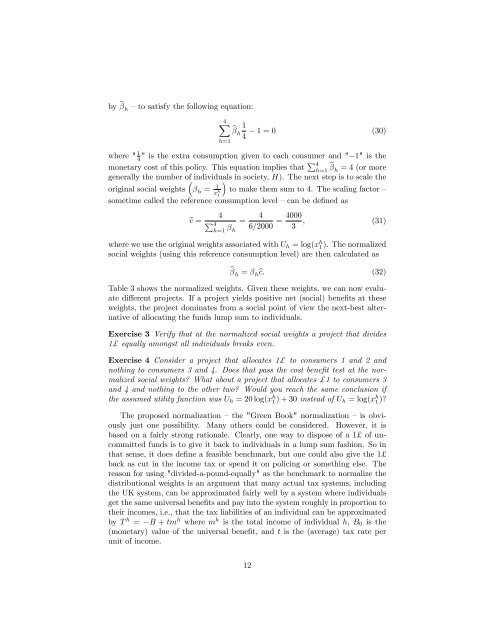Lecture Note 15: Social Cost Benefit Analysis - University of ...
Lecture Note 15: Social Cost Benefit Analysis - University of ...
Lecture Note 15: Social Cost Benefit Analysis - University of ...
Create successful ePaper yourself
Turn your PDF publications into a flip-book with our unique Google optimized e-Paper software.
y b h –to satisfy the following equation:<br />
4X<br />
h=1<br />
b<br />
1<br />
h<br />
4<br />
1 = 0 (30)<br />
where " 1<br />
4 " is the extra consumption given to each consumer and " 1" is the<br />
monetary cost <strong>of</strong> this policy. This equation implies that P 4<br />
h=1 b h = 4 (or more<br />
generally the number <strong>of</strong> individuals in society, H). The next step is to scale the<br />
to make them sum to 4. The scaling factor –<br />
sometime called the reference consumption level –can be de…ned as<br />
original social weights h = 1<br />
x h 1<br />
bc =<br />
4<br />
P4 =<br />
h=1 h<br />
4<br />
6=2000<br />
4000<br />
= ; (31)<br />
3<br />
where we use the original weights associated with Uh = log(x h 1). The normalized<br />
social weights (using this reference consumption level) are then calculated as<br />
b h = hbc: (32)<br />
Table 3 shows the normalized weights. Given these weights, we can now evaluate<br />
di¤erent projects. If a project yields positive net (social) bene…ts at these<br />
weights, the project dominates from a social point <strong>of</strong> view the next-best alternative<br />
<strong>of</strong> allocating the funds lump sum to individuals.<br />
Exercise 3 Verify that at the normalized social weights a project that divides<br />
1£ equally amongst all individuals breaks even.<br />
Exercise 4 Consider a project that allocates 1£ to consumers 1 and 2 and<br />
nothing to consumers 3 and 4. Does that pass the cost bene…t test at the normalized<br />
social weights? What about a project that allocates £ 1 to consumers 3<br />
and 4 and nothing to the other two? Would you reach the same conclusion if<br />
the assumed utility function was Uh = 20 log(x h 1) + 30 instead <strong>of</strong> Uh = log(x h 1)?<br />
The proposed normalization – the "Green Book" normalization – is obviously<br />
just one possibility. Many others could be considered. However, it is<br />
based on a fairly strong rationale. Clearly, one way to dispose <strong>of</strong> a 1£ <strong>of</strong> uncommitted<br />
funds is to give it back to individuals in a lump sum fashion. So in<br />
that sense, it does de…ne a feasible benchmark, but one could also give the 1£<br />
back as cut in the income tax or spend it on policing or something else. The<br />
reason for using "divided-a-pound-equally" as the benchmark to normalize the<br />
distributional weights is an argument that many actual tax systems, including<br />
the UK system, can be approximated fairly well by a system where individuals<br />
get the same universal bene…ts and pay into the system roughly in proportion to<br />
their incomes, i.e., that the tax liabilities <strong>of</strong> an individual can be approximated<br />
by T h = B + tm h where m h is the total income <strong>of</strong> individual h, B0 is the<br />
(monetary) value <strong>of</strong> the universal bene…t, and t is the (average) tax rate per<br />
unit <strong>of</strong> income.<br />
12


